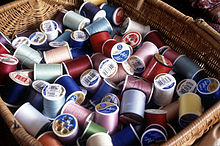Thread (yarn)
A thread is a long strand of material, often composed of several filaments or fibres, used for joining, creating or decorating textiles.Ancient Egyptians were known for creating thread using plant fibers, wool and hair.[1] Today, thread can also be made of many different materials including but not limited to cotton, wool, flax, nylon, silk, polyester etc.Thread is similar to yarn, cord, twine, or string, and there is some overlap between the way these terms are used.However, thread is most often used to mean materials fine and smooth enough for sewing, embroidery, weaving, or making lace or net.Heavy goods that must withstand considerable stresses such as upholstery, car seating, tarpaulins, tents, and saddlery require very strong threads.It is common to wrap three strands of the same weight to make one thread, though this is not a formal requirement in the US standard (which is therefore less informative).A slightly heavier silk buttonhole thread suitable for bartacking, small leather items, and decorative seams might be tex 40.The cotton count system is based on the number of 840 yard hanks that will result from a single pound of a particular finished thread.This is the cotton count size of the thread divided by the number of plies which make it up.Bonded nylon sewing threads are tough, coated with abrasion resistance, rot proofing, and have good tensile strength for lower temperature applications.


Threads (social network)Thread (online communication)Supplemental Symbols and PictographsAncient Egyptianscottonpolyesterstringsewingembroideryweavingupholsterycar seatingtarpaulinssaddlerybindingappliquébeadworkcellulosehomespunWater-solubletemperaturesKevlarstainless steelflame-resistantflame-retardantabrasiontensile strengthEisengarnHank (textile)Sewing needleStaple (textiles)Stitch (textile arts)BastingDarningEmbellishmentFabric tube turningFloating canvasGatherGore (fabrics)GussetHeirloom sewingShirringStitchesBackstitchBar tackBlanketBlind stitchButtonholeCatch stitchChain stitchCoverstitchCross-stitchEmbroidery stitchHemstitchLockstitchOverlockPad stitchPick stitchRanteringRunningSashikoStoatingTopstitchZigzagNecklineFelled seamSeam allowanceStyle lineNotionsBias tapeCollar stayElasticGalloonGrommet/eyeletInterfacingPassementeriePipingRuffleRickrackSelf-fabricSoutacheTwill tapeWrightsBuckleButtonHook-and-eyeHook-and-loop fastenerZipperGrain/biasSelvageTextile/fabricBobbinDress formNeedlecaseNeedle threaderPattern notcherPincushionPinking shearsScissorsSeam ripperSewing gaugeStitching awlTailor's hamTape measureThimbleTracing paperTracing wheelTradesCloth merchantDraperDressmakerHaberdasherMercerSilkwomanTailorPatternsButterickClothkitsMcCall'sSimplicityMachinesBarthélemy ThimonnierBerninaBrotherElias HoweFeiyue